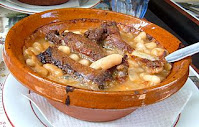 | |
| Cassoulet in a traditional pan. Wikimedia Commons. | |
Wikipedia pretty much agrees with the author's definition of casserole. Wikipedia defines "casserole," at least as the term is understood in the United States, as "a baked food with three main components: pieces of meat (such as chicken or ground meat) or fish (such as tuna) or other protein (such as beans or tofu), various chopped or canned vegetables (such as green beans or peas), and a starchy binder (such as flour, potato, or pasta); sometimes, there is also a crunchy or cheesy topping."
Other countries use the term "casserole" to describe dishes that are more like the stews I prefer. Wikipedia says: "In English-speaking Commonwealth countries like the United Kingdom, Australia, and New Zealand, the term casserole is most commonly used to refer to a dish of meat or chicken with vegetables and a gravy-style sauce; dishes containing a large proportion of starchy ingredients, e.g. pasta or potatoes, or those cooked in creamy sauces are not generally referred to as casseroles, and might be called 'bakes' or 'gratins.' The French term "cassoulet," which describes a bean stew with meat, may be the source of our term "casserole." It is traditionally made in a ceramic pot of an unusual shape, unlike the slow cooker I use or the deep squarish pan used to make casseroles in the oven. (A picture of the French-style cassoulet pan appears above.)
The article's author expresses the belief that the American-style casserole arose from the conjunction of two different elements: the Scandinavian customs that arrived with the people who settled the American Midwest; and the economic scarcity that troubled mid-twentieth century America.
"This is how the casserole worked its way onto our tables. A dish born of poverty and convenience. A dish both overly processed and perfectly delicious. Casserole is ubiquitous and to the haters, bland. (To which I say, add spice! Casseroles are what you make them.) But the point is a fair one. A casserole in its essence is a dish of comfort and a dish of hot, ready, cheap proteins and carbs."
Though the types of recipe featured in the article are not tempting to me, the article is a good read about the conditions under which the modern "casserole" sprang. I commend it to my readers' attention.
No comments:
Post a Comment